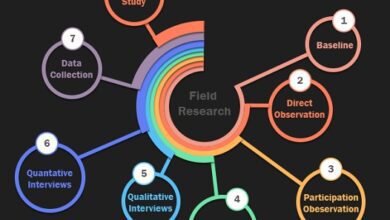What is Ethnographic Research Origin Features methods Examples
Scientific investigation can have different approaches, as is the case with ethnographic research. This method is widely used in the Social and Human Sciences, enabling studies in different areas – from education to marketing.
Ethnography is a qualitative research methodology . Therefore, it has a subjective character and the results cannot be represented in exact numbers.
What is ethnographic research?
The word ethnography is the result of the combination of two Greek terms: ethnos (which means people) and graphein (which means writing).
The Aurélio dictionary defines ethnography as “part of anthropological studies that corresponds to the stage of elaboration of data obtained in field research”.
Aurélio’s second definition is “a descriptive study of one or more social or cultural aspects of a people or social group”.
Ethnographic research is field research. , in which the researcher needs to be immersed in the context to collect information. This type of study is not considered fast, after all, there is a need for at least one year of immersion.
The main factor that differentiates ethnographic research from others is that the researcher needs to live as a member of the studied community. Therefore, it is not enough just to apply questionnaires or conduct interviews. It is necessary to participate in people’s lives.
Whoever conducts an ethnographic study assumes the role of a full-time participating researcher and not just an observing researcher.
Ethnography as a scientific research approach brings some contributions to the field of qualitative research, in particular for studies that are interested in social inequalities, processes of exclusion and socio-interactional situations.
Carmem Lúcia Guimarães de Mattos, PhD in Education Culture And Society .
Origin
The origin of ethnographic research lies in anthropology, a social science that flourished during the Enlightenment (1715 – 1789).
Travelers, merchants and missionaries analyzed social groups based on experience reports. This type of research was often applied in different European tribes, villages and other contexts.
Features
- Interaction between researcher and researched object;
- Identifies, designs and understands the culture of a group;
- Understanding of local forms of communication;
- Usually the researcher belongs to a different culture;
- Flexibility to modify the directions of the research;
- The process of carrying out the study is considered more important than the final results;
- Each subject in the group is free to present his point of view about the experiences in the social group;
- The researcher does not interfere in the researched environment.
Ethnographic research methods
Data collection in the research field can be performed using the following techniques:
participant observation
To learn about symbolic aspects, customs and rituals, the researcher must put into practice the participant observation technique. In this method, he shares all the experiences, circumstances and activities that surround him.
The participant observation process requires gaining the trust of the subjects involved, sensitivity in dealing with people, familiarity with the investigated issues and the ability to be a good listener.
direct observation
Those who carry out a study with an ethnographic approach must observe everything and everyone around them, but without forgetting that they are also being observed by social actors.
According to Lakatos and Marconi (2003, p.190), observation “does not consist only of seeing and hearing, but also of examining facts or phenomena that one wishes to study”.
Side dish
Through follow-up, the researcher is able to get to know closely the ways of life of the studied community. Your role is to understand the habits, needs, desires and circumstances that influence behavior.
intensive interview
the interview is an important tool for collecting life stories. Before carrying out it, the researcher needs to make a plan, that is, define time, place and questions.
The challenge is to conduct the interview so that it doesn’t look like an interview, but rather sounds like an ordinary conversation. In this chat, both ask and answer naturally.
The information collected during the interview helps to understand the interviewee, the group to which he belongs and the logic of the culture in which he is inserted.
Quiz
Questionnaires can be applied to the studied social group in order to obtain quantitative data. However, this instrument has only a complementary character, since the essence of the investigation is qualitative.
Recording of images, videos and audios
Writing down the data is not always enough. Therefore, it is worth having resources to take pictures, record videos and sound files.
The audiovisual documents, produced by the researcher himself, must be stored in a safe place, thus avoiding the risk of losing important records about the studied community. One suggestion is to save everything on Google Drive or an external HD.
Document Analysis
Documents belonging to the group, as well as reports, can be analyzed by the researcher as a strategy to enrich the research.
Reports
The reports allow you to create reports with stories and phrases that the researcher heard during his period of immersion in the community. This type of technique is considered a key element when doing ethnographic qualitative research.
Questions related to rituals, dances and drawings can also be part of the report.
Examples of ethnographic research
How to do ethnographic research?
The final product is not the emphasis of the study with an ethnographic approach. What really matters is the process. Here are the steps on how to do it:
Worry about the theoretical framework
The researcher needs to read books, scientific articles, theses and other documents to compose his theoretical framework on the research topic. In this way, he will have a theoretical basis in his analysis of how the community behaves.
When doing the bibliographic survey, it is important to consider canonical works and also contemporary studies on the subject. Everything that has already been said in the scientific literature about the chosen group needs to be known by the researcher.
find a problem
Before going to the field, it is necessary to have a well-defined problem, that is, a difficulty that the study intends to solve. The problem design is based on the investigator’s experience and also on the gaps identified during the literature review.
Make a field diary
Even before the immersion, the researcher needs to have a field notebook to write down questions that led to choosing the group. In addition, the journal is also a space to write down questions you have in mind about the topic of study.
As the researcher lives with the social group, he should record descriptive information in the field diary. In this report, it is necessary to register the data collected in the environment and that will be interpreted later.
Gain group acceptance
For ethnographic research to take place, one of the most important factors is the acceptance of the studied group.
In general, there is a need to obtain written authorization to search within the chosen scope. This formalization is especially important when the environment is a company, a school or a non-profit organization.
take a dip
The researcher needs to participate in the activities carried out by the members: practice the same activities, wear the same clothes and eat the same food.
Immersion also involves the application of data collection instruments, such as direct observation, participant observation,
Pay attention to the problem review
The ethnographic method has an aposteriori character, that is, when the researcher reviews and rediscovers the research problem as he experiences the day-to-day life of the studied community. The local elements discovered during the experiment can modify this initially designed problem.
Analyze and interpret the data
After living the immersion in the studied community, the researcher needs to analyze and interpret all the data collected during his experience. This must be done based on the theoretical framework.
Write the text clearly
The final report follows the good practices of scientific writing, that is, with clear and objective language. The structure of the sentences that make up the text follows the active voice (subject + verb + predicate).
The process of writing the text is not something alien to field research. These two processes, in fact, complement each other and are related.
The researcher’s gaze is constant throughout the investigation process, without giving in to preconceived and stereotyped ideas of common sense .

